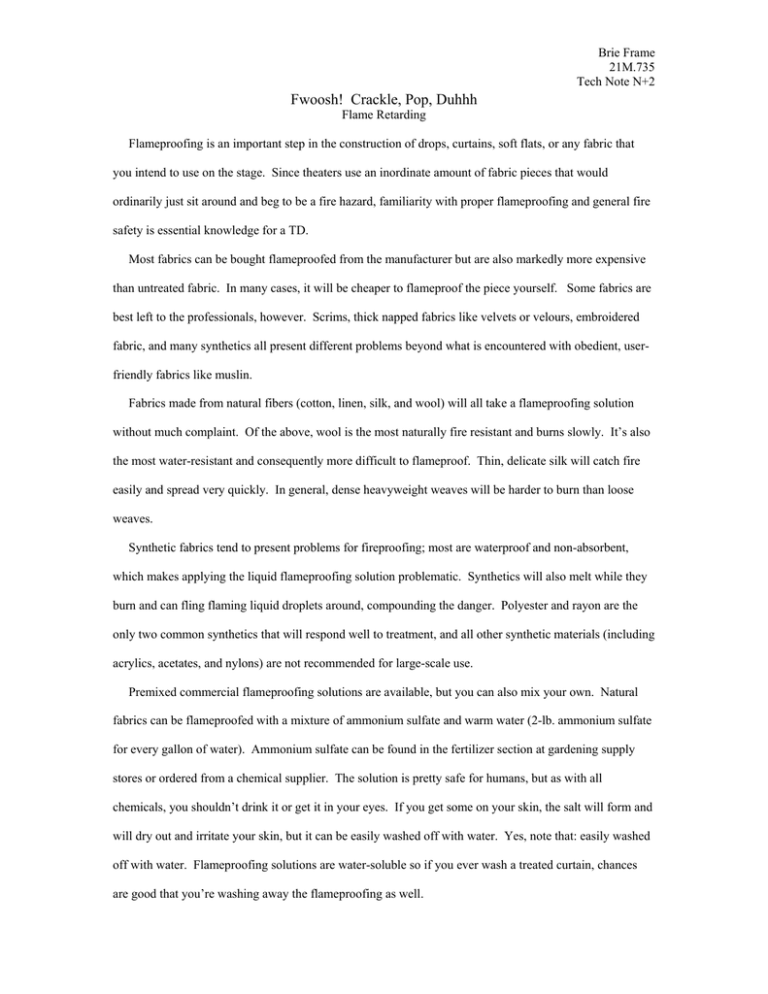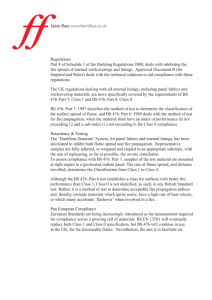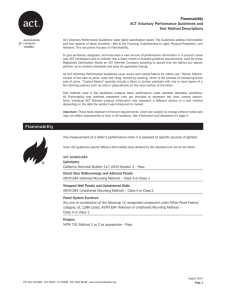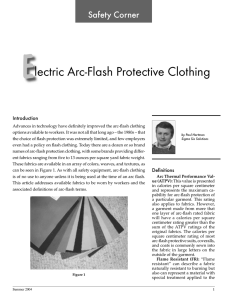Fwoosh! Crackle, Pop, Duhhh
advertisement

Brie Frame 21M.735 Tech Note N+2 Fwoosh! Crackle, Pop, Duhhh Flame Retarding Flameproofing is an important step in the construction of drops, curtains, soft flats, or any fabric that you intend to use on the stage. Since theaters use an inordinate amount of fabric pieces that would ordinarily just sit around and beg to be a fire hazard, familiarity with proper flameproofing and general fire safety is essential knowledge for a TD. Most fabrics can be bought flameproofed from the manufacturer but are also markedly more expensive than untreated fabric. In many cases, it will be cheaper to flameproof the piece yourself. Some fabrics are best left to the professionals, however. Scrims, thick napped fabrics like velvets or velours, embroidered fabric, and many synthetics all present different problems beyond what is encountered with obedient, userfriendly fabrics like muslin. Fabrics made from natural fibers (cotton, linen, silk, and wool) will all take a flameproofing solution without much complaint. Of the above, wool is the most naturally fire resistant and burns slowly. It’s also the most water-resistant and consequently more difficult to flameproof. Thin, delicate silk will catch fire easily and spread very quickly. In general, dense heavyweight weaves will be harder to burn than loose weaves. Synthetic fabrics tend to present problems for fireproofing; most are waterproof and non-absorbent, which makes applying the liquid flameproofing solution problematic. Synthetics will also melt while they burn and can fling flaming liquid droplets around, compounding the danger. Polyester and rayon are the only two common synthetics that will respond well to treatment, and all other synthetic materials (including acrylics, acetates, and nylons) are not recommended for large-scale use. Premixed commercial flameproofing solutions are available, but you can also mix your own. Natural fabrics can be flameproofed with a mixture of ammonium sulfate and warm water (2-lb. ammonium sulfate for every gallon of water). Ammonium sulfate can be found in the fertilizer section at gardening supply stores or ordered from a chemical supplier. The solution is pretty safe for humans, but as with all chemicals, you shouldn’t drink it or get it in your eyes. If you get some on your skin, the salt will form and will dry out and irritate your skin, but it can be easily washed off with water. Yes, note that: easily washed off with water. Flameproofing solutions are water-soluble so if you ever wash a treated curtain, chances are good that you’re washing away the flameproofing as well. Brie Frame 21M.735 Tech Note N+2 Another flameproofing solution for natural and absorbent fabrics uses borax and boric acid crystals (4oz. boric acid to 9-oz. borax per 1 gallon of warm water). The same safety concerns apply, only borax is a bit more of a concern if swallowed. In general, don’t drink the chemicals, people. Finally, there is a commercial solution called waterglass that can be used on paper, cardboard, and muslin. Waterglass is mostly sodium silicate and dries with a glossy finish but also tends to stiffen the fabric more than other solutions. Waterglass is good if you’re using large paper mache structures. Flameproofing solutions work by forming salts in the fabric. When exposed to flame, the salts form a layer of char on the surface of the fabric that inhibits spreading of the flame and will not support a flame unaided. The salts can make it difficult to paint the fabric later, so standard treatment of a painted muslin drop is to mix additives into the paint (such as Roscoflamex P50, for waterbased paints) and then flameproof the back of the drop afterwards. The final step in flameproofing is a quick test to make sure that the treatment worked. The typical standard is that a 1”x4” strip of treated fabric should be able to withstand the flame from a kitchen match held 1/2” beneath it for 15 seconds, does not spread the flame, and self-extinguishes when the flame source is removed. Brie Frame 21M.735 Tech Note N+2 References “Fire Retardants: An Advantageous Solution to Fire Protection.” Vince, National Fireproofing Co. http://www.fabrics.net/fireproofing.asp Backstage Handbook: an Illustrated Almanac of Technical Information. Carter, Paul. Broadway Press; Louisville, KY 1994. p. 139 “Flame Retardant Fabric.” SBI Fabric Finishing, 2004. http://www.sbifinishing.com/fr.html “Fire/Safety Regulations for Decorations and Public Events.” OSU Environmental Health and Safety Dept. September 2003. http://www.pp.okstate.edu/ehs/manuals/Decorate.htm








